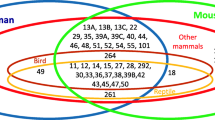Abstract
The clone 4921537P18 expressed preponderantly in mouse testis was identified by screening the Riken cDNA database, and two new full-length isoforms of this clone, which were named gsarp1 (Gonad Specific Ankyrin Repeat (ANK) Protein 1) and gsarp2, were found and isolated from mouse testis in the course of the research. Both of the GSARP1 and GSARP2 contain an ANK region circular composed by seven ANKs, and their structural feature is very similar to that of the IκB family proteins, while IκB proteins associate with the transcription factor NF-κB via their ANKs in the NF-κB pathway. We investigated the expression pattern at the mRNA level by Reverse transcription PCR. The gsarp1 has high expression level in mouse testis, while has low expression level in the ovary, and the gsarp2 is only expressed in mouse testis. The gsarp1 and gsarp2 begin to be detected at the early and later pachytene stage of meiosis separately, while both have high-expression level at the stage of MI and MII. The result of in situ hybridization reveals that the gsarp1 is primarily expressed in spermatocytes, while gsarp2 is expressed in spermatocytes and spermatids. In view of the structural feature and expression pattern of the GSARP1 and GSARP2, we speculate that they may play a certain role in a signal pathway of meiosis.











Similar content being viewed by others
References
Bork P (1993) Proteins Struct Funct Genet 17:363–374
Lux SE, John KM, Bennett V (1990) Nature 344:36–42
Andrade MA, Perez-Iratxeta C, Ponting CP (2001) J Struct Biol 134:117–131
Sedgwick SG, Smerdon SJ (1999) Trends Biochem Sci 24:311–316
Bennett V (1992) J Biol Chem 267:8703–8706
Bennett V, Gilligan DM (1993) Annu Rev Cell Biol 9:27–66
De Matteis MA, Morrow JS (1998) Curr Opin Cell Biol 10:542–549
Thompson CC, Brown TA, McKnight SL (1991) Science 253:762–768
Blank V, Kourilsky P, Israel A (1991) EMBO J 10:4159–4167
Blank V, Kourilsky P, Israel A (1992) Trends Biochem Sci 17:135–140
Michaely P, Bennett V (1995) J Biol Chem 270:22050–22057
Gorina S, Pavletich NP (1996) Science 274:1001–1005
Baumgartner R, Fernandez-Catalan C, Winoto A, Huber R, Engh RA, Holak TA (1998) Structure 6:1279–1290
Li J, Byeon IJ, Ericson K, Poi MJ, O’Maille P, Selby T, Tsai MD (1999) Biochemistry 38:2930–2940
Bell S, Matthews JR, Jaffray E, Hay RT (1996) Mol Cell Biol 16:6477–6485
Batchelor AH, Piper DE, de la Brousse FC, McKnight SL, Wolberger C (1998) Science 279:1037–1041
Gorina S, Pavletich NP (1996) Science 274:1001–1005
Batchelor AH, Piper DE, de la Brousse FC, McKnight SL, Wolberger C (1998) Science 279:1037–1041
Baeuerle PA (1998) Curr Biol 8:R19–R22
Ghosh S, May MJ, Kopp EB (1998) Annu Rev Immunol 16:225–260
Vogel T, Speed RM, Ross A, Cooke HJ (2002) Mol Hum Reprod 8:797–804
Thompson JD, Higgins DG, Gibson TJ (1994) Nucleic Acids Res 22:4673–4680
Cai H, Hu J, Song P, Gong W, Guo M (2006) Mol Biol Rep 33(3):159–166
Gu S, Hu J, Song P, Gong W, Guo M (2005) Mol Biol Rep 32(4):247–255
Frohman MA, Dush MK, Martin GR (1988) Proc Natl Acad Sci 85:8998–9002
Song P, Malhotra P, Tuteja N, Chauhan VS (1999) Biochem Biophys Res Commun 255:312–316
Lv D, Song P, Chen Y, Gong W, Mo S (2005) Biochem Biophys Res Commun 329(2):632–637
Bellve AR, Cavicchia JC, Millette CF, et al (1977) J Cell Biol 74:68–85
Toshima J, Koji T, Mizuno K (1998) Biochem Biophys Res Commun 249:107–112
Davis JQ, Bennett V (1990) J Biol Chem 265:17252–17256
Franzoso G, Bours V, Park S, Tomita-Yamaguchi M, Kelly K, Siebenlist U (1992) Nature 359:339–342
Wulczyn FG, Naumann M, Scheidereit C (1992) Nature 358:597–599
Thompson JE, Philips RJ, Erdjument-Bromage H, Tempst P, Ghosh S (1995) Cell 80:573–582
Franzoso G, Bours V, Azarenko V, Park S, Tomita-Yamaguchi M, Kanno T, Brown K, Siebenlist U (1993) EMBO J 12:3893–3901
Inoue J, Takahara T, Akizawa T, Hino O (1993) Oncogene 8:2067–2073
Bours V, Franzoso G, Azarenko V, Park S, Kanno T, Brown K, Siebenlist U (1993) Cell 72:729–739
Fujita T, Nolan GP, Liou HC, Scott ML, Baltimore D (1993) Genes Dev 7:1354–1363
Huxford T, Huang DB, Malek S, Ghish G (1998) Cell 95:759–770
Michel F, Soler-Lopez M, Petosa C, Cramer P, Siebenlist U, Muller CM (2001) EMBO J 20:6180–6190
Evans GJO, Morgan A (2003) Biochem Soc Trans 31(4):824–827
Rechsteiner M, Rogers SW (1996) Trends Biochem Sci 21:267–271
Acknowledgments
This work was supported by grants from the ICGEB International Center for Genetic Engineering and Biotechnology (ICGEB) (CRP/CHNO2-01), the National Basic Research Program of China (No. 2004CB117400), and the National Natural Science Foundation of China (No. 00510494; No. 30270675).
Author information
Authors and Affiliations
Corresponding author
Rights and permissions
About this article
Cite this article
Wang, F., Hu, J., Song, P. et al. Two novel transcripts encoding two Ankyrin repeat containing proteins have preponderant expression during the mouse spermatogenesis. Mol Biol Rep 34, 249–260 (2007). https://doi.org/10.1007/s11033-006-9039-1
Received:
Accepted:
Published:
Issue Date:
DOI: https://doi.org/10.1007/s11033-006-9039-1




